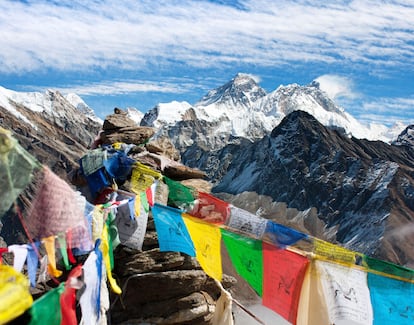Four wealthy clients to attempt Everest with the help of xenon gas
The amateur mountaineers will pay over $150,000 per head to climb to the roof of the planet, given over to the promises of noble gas, considered doping in athletics as it is an alternative way of increasing EPO

The immediacy that dominates everything has also reached Everest. Now, tourists on the world’s highest mountain want to skip the tedium of waiting at base camp, the discomfort of sleeping in tents, the cold at night, the rotations to acclimatise to the altitude, or the unappealing latrines. For those who have the financial capacity to lay out just shy of $155,000 for a week, an Austrian company has come up with a marketing gimmick that is as effective as it is controversial: inhaling xenon gas. Using this trick, four English tourists have accepted the challenge of leaving home, standing on the summit of Everest, and returning to their daily affairs within seven days, as reported recently by the Financial Times.
The only requirement, aside from money, is flexibility: when a window of good weather is announced, they will jump on a plane, land in Kathmandu, be taken to a clinic where they will inhale the gas for half an hour, and then fly by helicopter to base camp, 5,300 meters above sea level. They will then spend three days climbing the mountain using artificial oxygen and one day descending before flying back home. The plan ignores sudden changes in the weather on the mountain, or endless queues near the summit, and is somewhat misleading: in reality, all four candidates will carry out their acclimatization at home, with an eight-week treatment in hypoxia chambers, a strategy that has already been successfully used by many athletes.
Xenon gas is commonly used in fields such as aerospace and medicine, especially as an anesthetic and organ-protecting agent, although “recently, its role in the activation of the hypoxia-inducible factor HIF-1α, a kind of molecular switch that the body activates when it detects a reduction in oxygen availability, is being studied,” explains Adrián Castillo, physiologist, researcher and one of the founders of Fissac, a prestigious platform for dissemination in the field of exercise sciences.
Castillo explains how “when we are at altitude, or when we suffer a cardiac event in which the blood supply is reduced, this factor is activated in order to increase the mechanisms responsible for counteracting this hypoxia. Studies in animals, in vitro and, recently, in humans, have shown that exposure to this gas can acutely increase erythropoietin, a hormone produced mainly by the kidneys that plays a crucial role in the production of red blood cells, the cells that transport oxygen in the blood.” It would be, he says, “an alternative way of increasing EPO, a substance that our body produces naturally but that can also be used as a method of improving performance artificially. For this reason, both EPO and, more recently, this gas, since the Sochi Winter Games [in 2014], are considered doping.
Ethical considerations in the world of mountaineering have always been subjective, as it is not an activity subject to competition rules. In fact, using bottled oxygen or substances such as dexamethasone are obvious cheats in the eyes of many. Today, the notion that anything goes, including helicopter flights to Camp 2, has become widespread when it comes to climbing Everest.
A priori, the use of xenon gas is not a miracle treatment that drastically increases the chances of success for the four candidates. Rather, it seems like a pompous advertising gimmick, even though Lukas Furtenbach, head of the company that organizes the challenge, claims to have used this gas successfully. “The studies are not conclusive in this regard: it is not known whether this increase in the acute production of erythropoietin linked to exposure to this gas translates, in the long term, into greater performance or an increase in blood volume. One study shows that, for example, four weeks of exposure to this gas did not increase the creation of new red blood cells, nor the volume of blood, nor performance,” says Castillo.
On December 20, Castillo and Aitor Viribay (head of nutrition at the INEOS cycling team) posted the 10th and final podcast of the “90 grams” series on Spotify, where they revealed previously unpublished data collected by Kilian Jornet in 2017 during his double ascent of Everest without the aid of artificial oxygen. Here, the Catalan mountaineer himself reveals unknown data that is very useful to the scientific community: “At sea level I can run a kilometer in less than three minutes, but above 8,000 meters, going at my maximum, it could take me between one and three hours to complete a kilometer. Before leaving for Everest, I performed a maximum effort test and my respiratory rate at a VO2Max intensity was at 60-something breaths per minute. At 8,000 meters, at 130 beats per minute, which was the maximum I could reach up there, with a muscular oxygen saturation below 10% [which would be equivalent to a maximum effort, a sprint at sea level], my respiratory rate was more than 60 breaths per minute,” Jornet reveals.
Understanding how Jornet was able to “sprint” for hours “is something absolutely exceptional that breaks all the molds of current physiological knowledge,” says Castillo. And this illustrates the difference between climbing to the top of the planet without tricks, or doing so by reducing the severity of the natural environment to an unimaginable level.
Nowadays, the goal is to improve the metabolic aspect, that is, to produce the greatest amount of energy possible while saving oxygen, like Jornet, who climbed the mountain twice in the space of six days and whose training consisted of trying to be as efficient as possible for the summit, where there is barely 30% of the oxygen that humans use at sea level. In fact, Jornet sought to follow the example of the Sherpas, who “use much more glucose and lactate to obtain energy, because they are substrates that require less oxygen than fats. In this way, they use much less oxygen to produce the same energy,” says Castillo.
In 2017, Jornet suffered a blackout while descending from his first summit of Everest: he does not remember anything of what he did in an area close to 8,300 meters above sea level. His GPS trace indicates that he moved, climbed down, advanced, but his brain has erased that information. “The brain shuts down so as not to consume energy: normally the brain prioritizes fainting rather than continuing to walk, but on Everest the brain knows that if you don’t walk, you die, so it turns off almost all the alert systems so that you can continue advancing,” explains Jornet himself.
Sign up for our weekly newsletter to get more English-language news coverage from EL PAÍS USA Edition
Tu suscripción se está usando en otro dispositivo
¿Quieres añadir otro usuario a tu suscripción?
Si continúas leyendo en este dispositivo, no se podrá leer en el otro.
FlechaTu suscripción se está usando en otro dispositivo y solo puedes acceder a EL PAÍS desde un dispositivo a la vez.
Si quieres compartir tu cuenta, cambia tu suscripción a la modalidad Premium, así podrás añadir otro usuario. Cada uno accederá con su propia cuenta de email, lo que os permitirá personalizar vuestra experiencia en EL PAÍS.
¿Tienes una suscripción de empresa? Accede aquí para contratar más cuentas.
En el caso de no saber quién está usando tu cuenta, te recomendamos cambiar tu contraseña aquí.
Si decides continuar compartiendo tu cuenta, este mensaje se mostrará en tu dispositivo y en el de la otra persona que está usando tu cuenta de forma indefinida, afectando a tu experiencia de lectura. Puedes consultar aquí los términos y condiciones de la suscripción digital.
More information
Archived In
Últimas noticias
The open war against the oil ‘phantom fleet’
The new language of the workplace: Knowing how to ask AI questions is more important than using it
‘Sleepless City’: The light of cinema illuminates Madrid’s Cañada Real shantytown
Christmas loses its festive spirit: ICE fears cast shadow over religious celebrations
Most viewed
- Families demand repatriation of bodies of Colombians who died in Ukraine: ‘This war is a slaughterhouse for foreigners’
- The low-cost creative revolution: How technology is making art accessible to everyone
- Liset Menéndez de la Prida, neuroscientist: ‘It’s not normal to constantly seek pleasure; it’s important to be bored, to be calm’
- Christian Louboutin: ‘Young people don’t want to be like their parents. And if their parents wear sneakers, they’re going to look for something else’
- ‘El Limones’ and the growing union disguise of Mexican organized crime











































